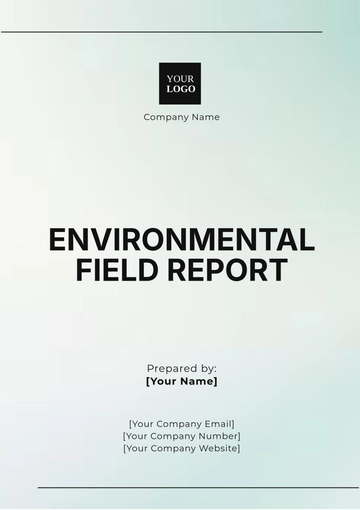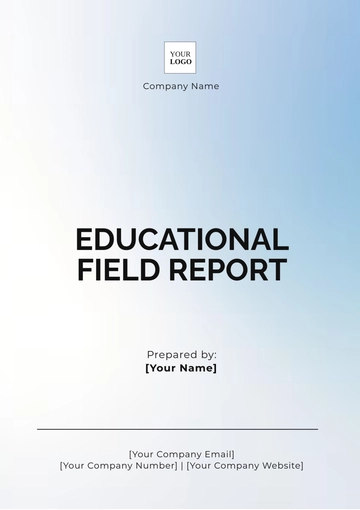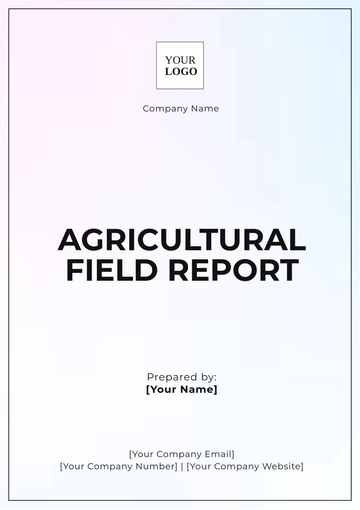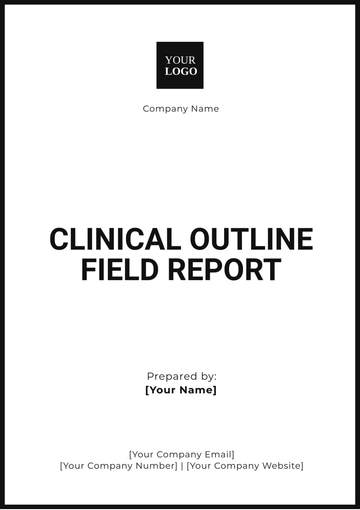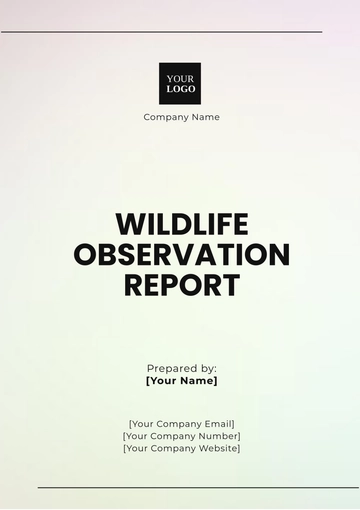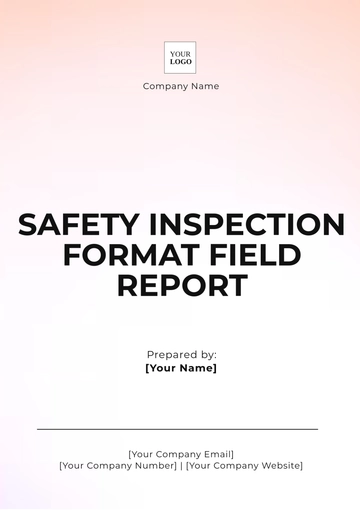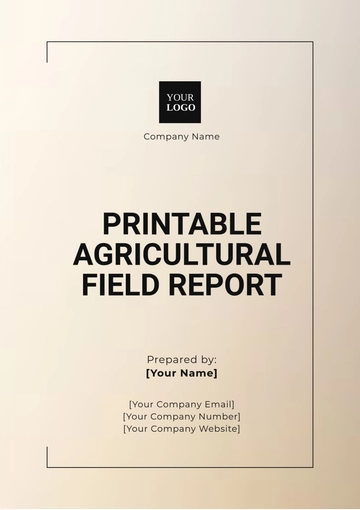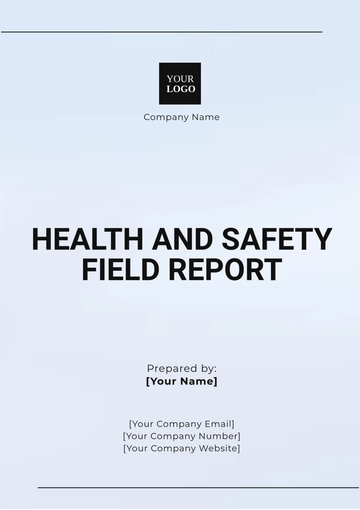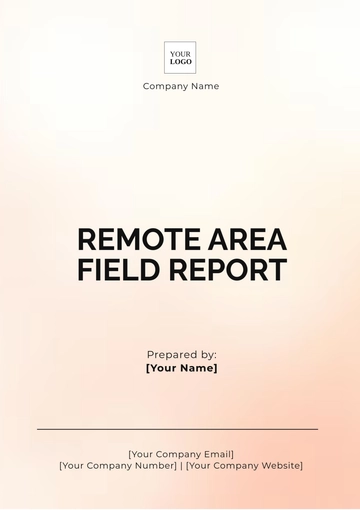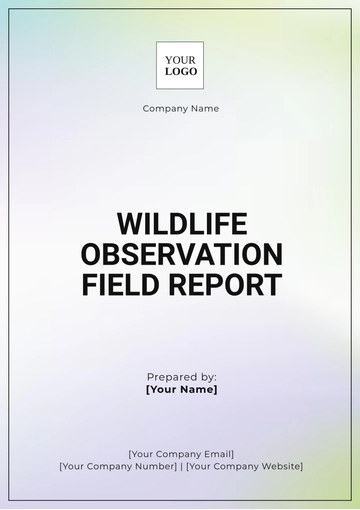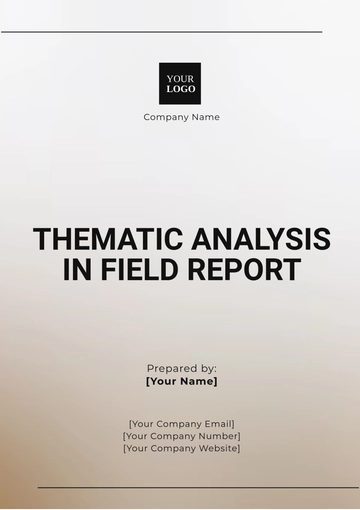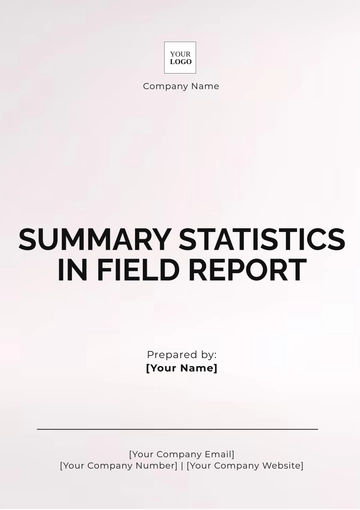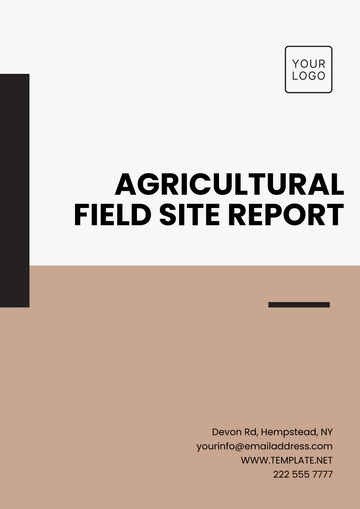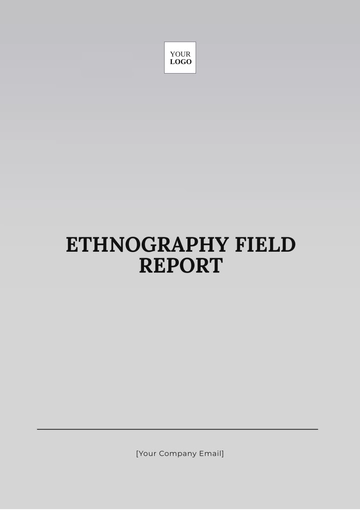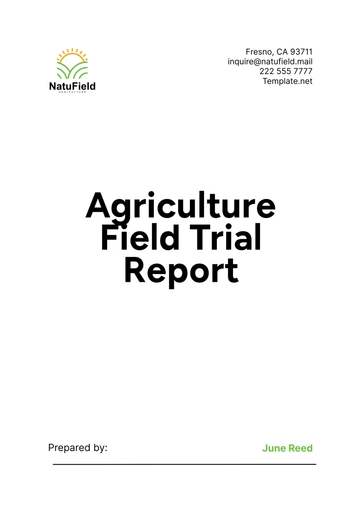Free Agriculture Field Trial Report
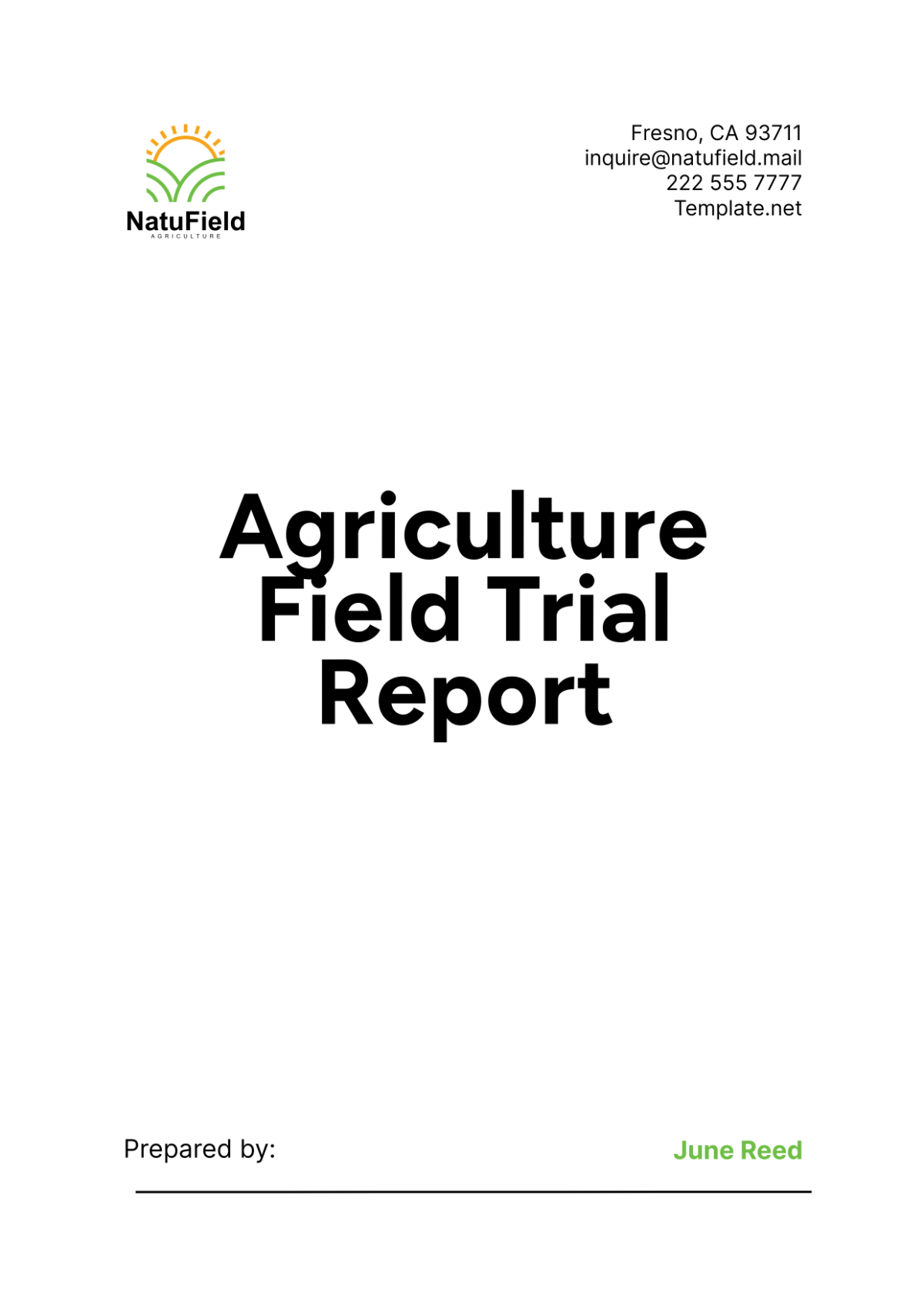
I. Introduction
A. Purpose of the Field Trial
The primary purpose of this field trial was to evaluate the effectiveness of the newly developed fertilizer, GreenGrow, on crop yield and quality. [Your Company Name] aimed to determine the potential benefits of GreenGrow compared to conventional fertilizers used in the industry. This trial was critical to understanding how GreenGrow performs under real-world agricultural conditions, including its impact on various crop types and its adaptability to different soil compositions. The findings of this trial will guide future recommendations and potential market strategies for GreenGrow.
B. Objectives
Evaluate Crop Yield: Assess the difference in crop yield between fields treated with GreenGrow and those treated with conventional fertilizers. This involves measuring the total harvestable produce per unit area and identifying any significant variations attributable to the fertilizer type.
Analyze Crop Quality: Compare the quality of crops, including size, color, and nutritional content, from the different treatments. Quality assessment will also include taste tests for edible crops, ensuring that GreenGrow does not adversely affect consumer preferences.
Monitor Soil Health: Observe any changes in soil health parameters such as pH, nutrient levels, and microbial activity. This objective ensures that GreenGrow maintains or improves soil health over time, promoting sustainable farming practices.
Economic Analysis: Perform a cost-benefit analysis to determine the economic feasibility of switching to GreenGrow. This includes evaluating the cost of the fertilizer, potential yield increases, and overall return on investment for farmers.
C. Scope of the Field Trial
The field trial was conducted over a period of one growing season, from planting to harvest. It involved multiple test sites across different geographic locations to account for variations in climate, soil type, and other environmental factors. The crops selected for this trial included corn, wheat, and tomatoes, representing a range of staple and cash crops. Each site was divided into plots treated with GreenGrow and plots treated with conventional fertilizers to allow for direct comparison.
II. Methodology
A. Site Selection and Preparation
Location Selection: The trial sites were selected based on their representativeness of common agricultural conditions. Locations included:
Midwest Corn Belt (Iowa)
Great Plains (Kansas)
Central Valley (California)
Plot Layout: Each site was divided into randomized plots of 1 acre each, with equal numbers assigned to GreenGrow and conventional treatments. This randomization helps to eliminate bias and ensure the reliability of the results.
Soil Preparation: Prior to planting, soil samples were taken to determine baseline nutrient levels, pH, and microbial activity. The soil was then tilled and prepared according to standard agricultural practices, ensuring uniform conditions across all plots.
B. Fertilizer Application
GreenGrow Treatment: GreenGrow was applied according to the manufacturer’s recommendations, with an initial application at planting and subsequent applications as needed based on crop growth stages and soil nutrient analysis.
Conventional Treatment: Conventional fertilizers were applied in line with current best practices for each crop type. This typically involved an initial application at planting followed by periodic top-dressing.
C. Planting and Maintenance
Planting Procedures: Crops were planted using standard mechanical planters, ensuring uniform seed depth and spacing. Planting dates were scheduled to optimize growing conditions for each crop type.
Irrigation and Weed Control: Standard irrigation schedules were maintained across all plots, with adjustments made based on weather conditions. Weed control was managed using mechanical and chemical methods as appropriate.
D. Data Collection
Yield Measurement: Harvest data was collected by measuring the total weight of produce from each plot. Additionally, subsamples were taken to assess average crop size and weight.
Quality Assessment: Crops were evaluated for quality metrics including size, color, and nutritional content. For tomatoes, taste tests were conducted to ensure consumer acceptability.
Soil Analysis: Post-harvest soil samples were collected to assess changes in nutrient levels, pH, and microbial activity. This data helps to determine the long-term impacts of GreenGrow on soil health.
Economic Data: Costs associated with fertilizer application, including labor and materials, were recorded. Yield and quality improvements were then analyzed to calculate the economic benefits of using GreenGrow.
III. Results
A. Crop Yield
Corn: The plots treated with GreenGrow showed an average yield increase of 15% compared to the conventional fertilizer plots. The yield data is summarized in Table 1
Location | GreenGrow Yield (bushels/acre) | Conventional Yield (bushels/acre) | Yield Increase (%) |
|---|---|---|---|
Iowa | 180 | 155 | 16.1 |
Kansas | 165 | 145 | 13.8 |
California | 190 | 165 | 15.2 |
Average | 178.3 | 155.0 | 15.0 |
Wheat: GreenGrow-treated plots produced an average yield increase of 12% over conventional plots.
Location | GreenGrow Yield (bushels/acre) | Conventional Yield (bushels/acre) | Yield Increase (%) |
|---|---|---|---|
Iowa | 70 | 62 | 12.9 |
Kansas | 75 | 67 | 11.9 |
California | 80 | 71 | 12.7 |
Average | 75.0 | 66.7 | 12.1 |
Tomatoes: There was a 10% increase in tomato yield with GreenGrow.
Location | GreenGrow Yield (tons/acre) | Conventional Yield (tons/acre) | Yield Increase (%) |
|---|---|---|---|
Iowa | 30 | 27 | 11.1 |
Kansas | 28 | 25 | 12.0 |
California | 35 | 32 | 9.4 |
Average | 31.0 | 28.0 | 10.7 |
B. Crop Quality
Corn: GreenGrow improved kernel size and color uniformity. Nutritional analysis showed a slight increase in protein content.
Wheat: The wheat quality was enhanced, with larger grain size and better milling quality.
Tomatoes: GreenGrow-treated tomatoes were larger, redder, and had higher sugar content, leading to better taste scores in consumer tests.
C. Soil Health
Nutrient Levels: Post-harvest soil analysis indicated that GreenGrow plots maintained higher nutrient levels compared to conventional plots, particularly in nitrogen and phosphorus.
pH Levels: Soil pH remained stable in GreenGrow plots, whereas slight acidification was observed in conventional plots.
Microbial Activity: There was a noticeable increase in microbial activity in the GreenGrow plots, suggesting a healthier soil ecosystem.
D. Economic Analysis
Cost of Application: The cost of GreenGrow was slightly higher than conventional fertilizers, but this was offset by reduced application frequency and labor costs.
Yield and Revenue: The increased yield resulted in higher revenue per acre, making GreenGrow economically viable despite the higher initial cost.
Return on Investment: ROI calculations showed that farmers could expect a 20-25% increase in profit when using GreenGrow compared to conventional fertilizers.
IV. Discussion
A. Interpretation of Results
The field trial results indicate that GreenGrow is an effective fertilizer that not only increases crop yield but also enhances crop quality and soil health. The higher nutrient retention and microbial activity in GreenGrow plots suggest that it promotes sustainable farming practices. The economic analysis further supports its adoption, highlighting the potential for increased profitability.
B. Comparison with Conventional Fertilizers
GreenGrow outperformed conventional fertilizers in almost all measured parameters. The significant yield increases across all crops, coupled with improvements in quality and soil health, demonstrate its superiority. The slight increase in cost is justified by the overall benefits, making GreenGrow a more sustainable and economically viable option for farmers.
C. Limitations of the Study
The trial was conducted over one growing season, which may not capture long-term effects of continuous GreenGrow usage. Additionally, the study was limited to three crop types, and further trials are needed to confirm its effectiveness on a broader range of crops. Environmental factors such as extreme weather conditions were not fully accounted for, which could influence the results.
D. Recommendations
Further Research: Conduct long-term studies to assess the sustainability and cumulative effects of GreenGrow on soil health and crop productivity.
Broader Crop Trials: Expand the trials to include a wider variety of crops to ensure GreenGrow's effectiveness across different agricultural systems.
Farmer Training: Develop training programs for farmers to optimize the use of GreenGrow and maximize its benefits.
Economic Incentives: Explore subsidy programs or financial incentives to encourage farmers to transition to GreenGrow.
V. Conclusion
A. Summary of Findings
The field trial conducted by [Your Company Name] demonstrated that GreenGrow is a highly effective fertilizer that significantly boosts crop yield and quality while promoting soil health. The trial results consistently showed higher yields across corn, wheat, and tomatoes when using GreenGrow compared to conventional fertilizers. Additionally, the improved crop quality and soil health metrics suggest that GreenGrow supports sustainable agricultural practices.
B. Implications for Agriculture
The adoption of GreenGrow has the potential to revolutionize agricultural practices by providing a sustainable and economically viable alternative to conventional fertilizers. Its ability to enhance crop yield and quality, coupled with its positive impact on soil health, positions GreenGrow as a key player in the future of farming. The economic benefits further underscore its value, offering farmers a pathway to increased profitability and long-term sustainability.
C. Future Directions
Policy Advocacy: Advocate for policies that support the use of sustainable fertilizers like GreenGrow, emphasizing their environmental and economic benefits.
Market Expansion: Explore opportunities to introduce GreenGrow to international markets, particularly in regions facing soil degradation and declining crop yields.
Technological Integration: Invest in research and development to enhance GreenGrow's formulation and application methods, integrating precision agriculture technologies to optimize its use.
VI. Appendices
A. Soil Test Results
Parameter | Pre-Trial Levels | Post-Trial Levels (GreenGrow) | Post-Trial Levels (Conventional) |
|---|---|---|---|
Nitrogen (ppm) | 10 | 18 | 12 |
Phosphorus (ppm) | 15 | 22 | 17 |
pH | 6.8 | 6.9 | 6.5 |
Microbial Activity (mg CO2/kg soil/day) | 50 | 75 | 60 |
B. Economic Data
Item | GreenGrow ($/acre) | Conventional ($/acre) |
|---|---|---|
Fertilizer Cost | 120 | 100 |
Application Cost | 30 | 40 |
Total Cost | 150 | 140 |
Yield Revenue (Corn) | 1783 | 1550 |
Yield Revenue (Wheat) | 750 | 667 |
Yield Revenue (Tomatoes) | 3100 | 2800 |
Net Profit (Corn) | 1633 | 1410 |
Net Profit (Wheat) | 600 | 527 |
Net Profit (Tomatoes) | 2950 | 2660 |
C. Crop Quality Metrics
Crop | Quality Metric | GreenGrow | Conventional |
|---|---|---|---|
Corn | Kernel Size (mm) | 12.5 | 11.8 |
Protein Content (%) | 9.5 | 9.2 | |
Wheat | Grain Size (mm) | 8.2 | 7.5 |
Milling Quality (Score) | 8.0 | 7.5 | |
Tomatoes | Average Weight (g) | 200 | 180 |
Sugar Content (Brix) | 6.5 | 6.0 |
- 100% Customizable, free editor
- Access 1 Million+ Templates, photo’s & graphics
- Download or share as a template
- Click and replace photos, graphics, text, backgrounds
- Resize, crop, AI write & more
- Access advanced editor
Document research findings with the Agriculture Field Trial Report Template on Template.net. It's editable and customizable, designed for scientific reporting. Utilize our Ai Editor Tool to present trial results clearly, facilitating data-driven decisions and advancements in agricultural innovation and crop management.
You may also like
- Sales Report
- Daily Report
- Project Report
- Business Report
- Weekly Report
- Incident Report
- Annual Report
- Report Layout
- Report Design
- Progress Report
- Marketing Report
- Company Report
- Monthly Report
- Audit Report
- Status Report
- School Report
- Reports Hr
- Management Report
- Project Status Report
- Handover Report
- Health And Safety Report
- Restaurant Report
- Construction Report
- Research Report
- Evaluation Report
- Investigation Report
- Employee Report
- Advertising Report
- Weekly Status Report
- Project Management Report
- Finance Report
- Service Report
- Technical Report
- Meeting Report
- Quarterly Report
- Inspection Report
- Medical Report
- Test Report
- Summary Report
- Inventory Report
- Valuation Report
- Operations Report
- Payroll Report
- Training Report
- Job Report
- Case Report
- Performance Report
- Board Report
- Internal Audit Report
- Student Report
- Monthly Management Report
- Small Business Report
- Accident Report
- Call Center Report
- Activity Report
- IT and Software Report
- Internship Report
- Visit Report
- Product Report
- Book Report
- Property Report
- Recruitment Report
- University Report
- Event Report
- SEO Report
- Conference Report
- Narrative Report
- Nursing Home Report
- Preschool Report
- Call Report
- Customer Report
- Employee Incident Report
- Accomplishment Report
- Social Media Report
- Work From Home Report
- Security Report
- Damage Report
- Quality Report
- Internal Report
- Nurse Report
- Real Estate Report
- Hotel Report
- Equipment Report
- Credit Report
- Field Report
- Non Profit Report
- Maintenance Report
- News Report
- Survey Report
- Executive Report
- Law Firm Report
- Advertising Agency Report
- Interior Design Report
- Travel Agency Report
- Stock Report
- Salon Report
- Bug Report
- Workplace Report
- Action Report
- Investor Report
- Cleaning Services Report
- Consulting Report
- Freelancer Report
- Site Visit Report
- Trip Report
- Classroom Observation Report
- Vehicle Report
- Final Report
- Software Report

